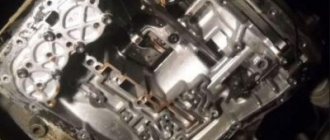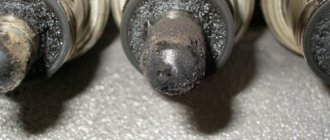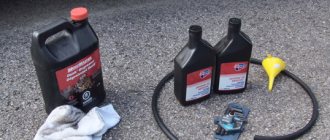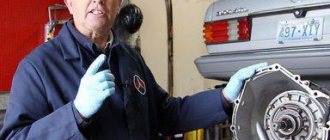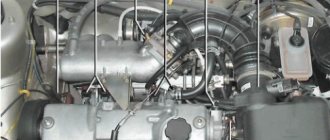When operating modern vehicles equipped with automatic transmissions, the transmission oil, as well as working units and parts of the automatic transmission, gradually become contaminated. Harmful sediments in the form of metal dust, shavings, fragments, combustion products and breakdown of friction clutches accumulate on working surfaces, filter screens, as well as in the cavities and channels of the hydraulic system. Flushing the automatic transmission is a necessary procedure to restore the stability of the transmission.
Why wash the box?
Flushing an automatic transmission before changing the oil is a rare procedure for service stations today.
The reason is not that it is expensive. It all lies in the ignorance of both car owners and service specialists. Most servicemen are not able to understand the intricacies and features of modern automatic transmissions.
In recent years, the main trend in car construction has been fuel economy, without sacrificing power and dynamics. Modern gearboxes already have 6, 8 or more steps, and shift much faster. To make the operation of the car even more economical, the torque converter has an additional clutch with partial high-frequency blocking - it improves acceleration dynamics, while the car does not consume a lot of fuel. But there are also disadvantages that are usually forgotten.
ATP liquid after 100 thousand mileage - it’s scary to imagine what kind of “mayonnaise” remains inside
The main disadvantage is the accumulation of wear products in the transmission fluid. These are small metal shavings, rubber dust, a product of the breakdown of torque converter clutches and other clutches in the box. The standard filter cleans oil from production, but not completely. A significant portion of chips and other particles circulates in the oil channels. The valves in the solenoids also wear out, since the latter are forced to work more often than on traditional 5-speed automatic transmissions. The situation is aggravated by the fact that manufacturers are switching gearboxes to oil with low viscosity - it protects parts less well from wear. And what do we see in the service book? The fluid is filled for the entire life of the car...
This box has already “arrived” at the capital
All this leads to the fact that most boxes are repaired after 60 thousand kilometers. And it doesn’t matter who the manufacturer of the automatic transmission is - the Japanese Aisin or the French AL4. But our car owners have long proven that even unsuccessful automatic transmission models can “run” 250 thousand kilometers. The secret is simple: timely maintenance and competent diagnostics.
Most service stations now do a partial replacement: drain half the waste volume and add fresh ATF in equal quantities. But there is one “but”: with such maintenance, most of the chips and dust remain inside, reducing the life of the box.
When a partial replacement does not help, car owners turn to automatic transmission flushing when changing the oil, which allows:
- reduce the likelihood of serious breakdowns of the automatic transmission;
- remove minor defects in the operation of the automatic transmission (vibrations, kicks) if they are caused by dirty channels and cavities.
Flushing fluids for automatic transmissions
5 minutes
Recently, the “5 minutes” washing agent has become in demand among Russian car enthusiasts. A universal liquid is used to clean gearbox components and engine oil filters.
Washing “5 minutes” removes not only hard metals and sediments in the automatic transmission system, but also varnish deposits on the surfaces of parts. The product is used using the traditional method indicated earlier.
The “5 minutes” liquid is created on the basis of a mineral lubricant with the use of chemical additives for quick flushing of the gearbox mechanisms. In addition, washing can eliminate metal products when parts wear out.
The low level of viscosity of the “5 minutes” product facilitates its penetration into difficult-to-pass areas of the automation system.
Cleaning Frequency
There have been no official studies regarding automatic transmission flushing, so it is difficult to say how often an automatic transmission should be flushed. Mechanics, based on personal experience, recommend performing the procedure before each ATP fluid replacement (that is, every 35-70 thousand kilometers).
Removed tray for washing
Sometimes it is worth performing non-scheduled flushing if there are:
- kicks when switching, which were not there before.
- jerking and jerking during acceleration;
- vibrations and other signs of unstable transmission operation.
Automatic transmission
An automatic transmission is a complex unit that changes gears without driver intervention, significantly simplifying the operation of the vehicle. The main element of the automatic transmission is the valve body, which is constantly lubricated and cooled, which ensures the performance of the transmission and the vehicle as a whole. It is in the valve body that various deposits and contaminants appear, the oil channels become clogged with metal shavings, which leads to significant problems in the operation of this unit.
If the transmission is seriously contaminated, lubrication of the moving elements deteriorates significantly, and the valve body overheats. As a result, the car owner has to perform an expensive overhaul of the transmission, the cost of which is comparable to replacing this unit.
Serious damage can be prevented and the life of the transmission can be extended by timely and proper flushing of the valve body and the entire automatic transmission.
If a car owner has basic car repair skills, he can easily wash the automatic transmission on his own without going to a workshop.
Advantages and disadvantages
Complete flushing will allow maximum removal of gear and clutch wear product from the channels and system. In addition, completely fresh oil is poured in, and not mixed with old oil, as with a partial replacement. And finally, flushing the automatic transmission, in addition to removing dirt, allows you to preserve the oil seals and seals of the valve body. This will extend the life of the hydraulic part and make the box work more adequately, without jerking and kicking.
There are no downsides if you do everything yourself. At the service station, the operation will cost a certain amount - this is the only negative.
Popular brands:
Audi S8, BMW 7-Series, Kia Rio
conclusions
Carrying out the procedure every time you change the lubricant will avoid serious contamination and increase the service life of the unit. There are two ways to wash the automatic transmission yourself. The method is selected by the motorist himself separately for each case. The assembly and disassembly technology differs depending on the car model.
Do not use aggressive substances for cleaning. They can damage seals, gaskets and components. By following the sequence of actions, you will be able to clean the valve body channels yourself.
Have you washed the automatic transmission yourself without specialized equipment? Which method did you use for your car?
We save the automatic transmission with our own hands - changing the oil with running in the video:
Standard method
In this case, the automatic transmission will be flushed with an oil change. What to do:
- .Drain the old oil. It is advisable to warm up the box (it is enough to drive 2-3 kilometers). The oil becomes more liquid and drains much faster.
- Find the drain hole on the bottom of the crankcase and unscrew the drain plug - this is a shortened bolt with a recessed head. Wait. until the liquid stops dripping.
- Remove the automatic transmission pan. Caution: Remember that the oil is still hot. The tray should be thoroughly washed from the outside as well as from the inside. It is recommended to degrease and wipe its surface dry.
- To flush the automatic transmission, prepare a pump, hoses of sufficient length and a suitable container. Connect the hoses to the cooling system of the box, start the engine. Washing takes from ten minutes to half an hour, depending on the degree of contamination of the box.
- After cleaning is completed, replace the oil filter and crankcase gasket. The filter is most often located at the bottom (near the valve) and is easily installed after removing the crankcase. The filter is attached to different automatic transmissions in different ways - from latches to bolt-on mounts. It is better to install the gasket on the sealant.
- Reinstall the tray.
- Add fresh oil.
Filling with new ATP fluid
Important! You need to pour exactly as much oil into the box as was drained before. Remember that both underfilling and overfilling are harmful to automatic transmissions.
- Check the level on the dipstick - it should be between minimum and maximum.
- Start and warm up the engine, take a short drive;
- Check the oil level, add if necessary. Also check for any leaks around the box. If they are not there, the replacement can be considered successful.
You can work according to a different scheme. Instead of oil, regular diesel fuel is poured into the automatic transmission. Then start the engine, let it run for 10–15 minutes and drain the liquid. If clean diesel fuel comes out, stop washing. If it is dirty, then cleaning with diesel fuel continues again with a new portion being poured. But experts do not recommend using dimexide - it is very aggressive towards friction clutches.
Washing the automatic transmission without removing it from the machine
This procedure is carried out using a special device. Standard list of work carried out by service station employees:
- First, the used old oil is drained. In order for the maximum amount of used fluid to flow out, the automatic transmission pan is removed and the drain plug is unscrewed.
- After draining the liquid, all parts are installed in their original places.
- A device filled with new transmission oil is connected.
- The engine starts.
- The motor runs for at least 15 minutes.
- At this time, oil under pressure passes through all channels of the automatic transmission hydraulic system.
- The ATF oil from the automatic transmission is drained again.
- The worn oil filter is removed and a new filter element is installed in its place.
- The automatic transmission pan gasket is being replaced.
- Fresh transmission oil is added.
Advanced cleaning
Sometimes it is not possible to wash all the dirt out of the automatic transmission. So, you can use a complicated method of completely washing the automatic transmission with your own hands. But the disadvantage of this technique is the need to dismantle the unit. You need to disassemble the box and wash each element. How the work is done:
- drain the old oil from the box;
- The automatic transmission is dismantled, disassembled, and each part is washed separately using washing chemicals;
- internal channels are purged with compressed air;
- The box is put back together and fresh oil is added.
Important! When assembling the box, new seals and gaskets must be installed.
After such an operation, you need to run the car in a gentle mode for a week. Despite the difficulties associated with the need to completely disassemble the automatic transmission, this method is more effective - using it, you can completely clean the insides of the transmission from wear products.
What you need to prepare for washing the automatic transmission
This event is best carried out in specialized workshops. Most service companies are equipped with special washing devices, with the help of which the unit is washed at the proper professional level. If during diagnostics it turns out that it is necessary to disassemble the automatic transmission and change some parts and components, the box is rebuilt, all its elements are washed in gasoline, and the channels are purged with compressed air.
If you decide to flush the automatic transmission yourself, you need to create the conditions and acquire consumables, auxiliary tools, and accessories:
- Transmission fluid in double volume (the first portion of ATP oil will be used for flushing the unit, the second - for refueling, respectively).
- Adjustable wrenches, sockets, polygons, gasoline, screwdrivers, pump.
- Bucket or basin for waste material.
- Cotton rags.
- Observation deck, overpass.
Pallet
It happens that a layer of dirt accumulates in the automatic transmission crankcase, which cannot be washed without removal. It is secured differently on different cars, but the principle is the same - unscrew the bolts along the contour. You can clean it with whatever you have at hand - gasoline, carburetor cleaning fluid and even dimexide (this is where it is safe to use). The liquid is simply poured into the crankcase, given time for the dirt to dissolve and drained. Wipe dry with a rag and put the tray in place.
Do-it-yourself crankcase cleaning
Often car owners, when washing the box themselves, use gasoline. But if the contamination is severe (and it happens that almost black oil drains from the crankcase), gasoline does not help. You can try a product from household stores - Shumanit. The product corrodes any contaminants. You can also use diesel fuel, kerosene, five-minute flush and other similar liquids as a liquid.
How to flush the automatic transmission yourself
It is possible to flush the automatic transmission without specialized equipment either without disassembling the unit or with dismantling some parts. The first method is simpler - it allows you to clean the transmission assembly from minor contaminants. The second method is more difficult to perform and requires tools and basic knowledge in car repair. The sequence of actions depends on the chosen method.
No disassembly
Before flushing, warm up the transmission to operating temperature. This is necessary to reduce the viscosity of the lubricant. To warm up, drive the vehicle for 15-20 minutes.
Automatic transmission flushing sequence:
CAUTION: Waste fluid from a warm transmission is at a high temperature. When removing the plug, you must stand aside. To avoid oil getting into exposed skin and eyes, personal protective equipment is used - goggles, gloves, etc.
After washing, check the performance of the automatic transmission. To do this, the transmission is warmed up to operating temperature, after which it is tested in various modes.
Some motorists use diesel fuel or ready-made additives for flushing, which are added to used lubricant. Auto mechanics do not recommend cleaning channels this way. Aggressive substances can negatively affect components. This will damage the transmission and make the vehicle impossible to use.
With disassembly
In some cases, a complete automatic transmission flush may be necessary. The transmission design and disassembly technology differs depending on the car model. Washing is carried out in the following sequence:
It is better to disassemble the hydraulic unit on an easy-to-clean surface, free of dust and small abrasive particles. The part is washed with cleaning compounds and blown with compressed air.
During the work, you should pay attention to the position of the dismantled parts. Failed components are replaced with new ones. The sealing gaskets must also be replaced.
Assembly is carried out in reverse order. Afterwards, new fluid is added, the transmission is warmed up and tested in different modes.
Composition for soft washing of automatic transmissions
Why you need to check the oil level in an automatic transmission and how to do it can be read in our article here.
Flushing the hydraulic unit
Cleaning the automatic transmission valve body is not as scary as they write or talk about it. It is necessary to unscrew the valve body mounting bolts and carefully remove the part downwards. The solenoids can be cleaned using carburetor cleaner.
Cleaning the valve body
Small parts are also washed with carb cleaner. But it is better to wash the stove with gasoline, kerosene or diesel fuel - soak it overnight, rinse and dry.
What's the result?
As you can see, in addition to hardware replacement and the displacement method, there are also special flushing additives for automatic transmissions or flushing oils for automatic transmissions. Some owners also use kerosene or gasoline.
Automatic transmission repair and maintenance specialists recommend cleaning with special means only in case of urgent need, that is, avoiding additives or cleaning compounds. In other words, it is best to clean the automatic transmission with transmission oil, which is completely suitable in properties for a particular automatic transmission.
To avoid contamination of the box, it is better to change the oil in a timely manner, and also make allowances for operating conditions (the replacement is made earlier than required by regulations). This approach allows us to eliminate the risks that arise after using automatic transmission flushing oils, cleaning additives for waste, and, especially, kerosene, gasoline or diesel fuel.
Washing the automatic transmission filter
There are two types of filters for automatic transmissions:
- Reusable with fine mesh element. Such filters can be saved by washing.
- Paper or synthetic filters. They are not washed, but replaced with new ones.
The filter is usually cleaned when flushing the automatic transmission housing. You can do this yourself - the first step is to drain the old oil, remove the crankcase and dismantle the filter.
Cleaning the filter
The body of the latter may be covered in plaque or dirt. Carburetor cleaning fluid can easily remove this dirt. Once the housing is clean, you can disassemble the filter. Depending on how dirty it is, the mesh is washed with the same carb cleaner or gasoline. Wash until the mesh is visible. When its cells are clearly visible, the structure can be assembled.
Complete automatic transmission cleaning
Often new car owners are interested in how to flush an automatic transmission at home. For a complete flush, you will need to disassemble the machine down to spare parts. If the car owner does not have certain skills, then it is recommended to use the washing method described above or take the car to a service station.
Do-it-yourself repair of automatic transmission BTR M11
Pallet
To start flushing, you need to drain all lubricant from the automatic transmission. And then start disassembling the machine.
The procedure is performed like this:
Remove the old filter device. Now you can start flushing the valve body.
Flushing the automatic transmission valve body
To wash the automatic transmission with your own hands, as experienced mechanics do, you need to dismantle the hydraulic plate.
Original oil and analogues for Honda automatic transmissions
Leave to dry on the table and move on to the filter device.
Washing the automatic transmission filter
Experts recommend replacing the box filter after 70,000 kilometers. However, if the car owner started flushing the automatic transmission before driving the required amount of kilometers, then he can wash the filter device and not install a new one. Use WD40 to wash the filter.
Flushing the automatic transmission torque converter
After the hydraulic unit has been removed, you need to completely dismantle the box. It should be noted that its weight starts from 65 kg. It all depends on the configuration. Therefore, it is advisable to carry out all work with a partner and having special lifts in the garage.
After the machine is removed, it is necessary to disassemble it.
After this, you can begin flushing the radiator, installing components back and changing the oil.
Flushing the transmission radiator
After all components have been washed and individual used automatic transmission parts have been replaced, you need to start cleaning the cooling system. It plays the main role and prevents the entire automatic transmission from overheating.
Many car owners recommend using kerosene to flush the radiator. But usually such a procedure is fraught with problems, which will be discussed in the next block.
To flush the radiator, you need to take a circular pump, oil and drive the lubricating fluid through the pipes of the cooling system.
After drying all the components, reassemble the automatic transmission in the reverse order and install it on the car. Fill with new oil. Drive ten kilometers and measure the level. If necessary, top up.
Diagnostics and repair of Mazda 6 automatic transmission
Flushing the automatic transmission torque converter
It is almost impossible to do this procedure on your own. Flushing the torque converter is only possible if you cut the donut. Without opening, washing is ineffective and will not have any noticeable effect.
Opening the torque converter
If the housing is sawn, then all the elements of the torque converter immediately become accessible - you can visually assess the scale of the problem. After troubleshooting, cleaning begins. Thoroughly wash the turbine blades and elements in the clutch mechanism.
The cleaning procedure is simple - the part is immersed in a container with a high concentration cleaning solution and the carbon deposits are washed off manually. After cleaning, all dismantled elements are installed back, and the torque converter housing is welded. Next, the system is checked for leaks.
Flushing the transmission radiator
The automatic transmission gets very hot during operation, and therefore it has a cooling system with a separate heat exchanger. If the latter is not dirty, it will cope with heat removal without any problems. But as soon as a layer of dirt accumulates in the channels, the box overheats.
Cleaning the heat exchanger inside
The radiator is washed together with the gearbox before changing the oil. The most effective method is a mixture of alcohol and aqueous solvents. The service station has a washing stand for this purpose. But in a garage you can use a circulation pump yourself. How it all happens:
- remove the automatic transmission oil pipes;
- a hose coming from the pump is connected to the inlet pipe;
- the second pipe is inserted into a container suitable for washing;
- the receiving container is filled with solvent;
- The liquid is pumped into the radiator through the “return” hose (that is, it should pour out from the supply part).
- turn on the pump for up to 15 minutes.
Next, the solvent is drained. If it turns out to be very dirty, the procedure is repeated. If instead of a solvent you use a cleaning agent in aerosol cans, cleaning is carried out according to the same scheme - from supply to return. You need to pour in so much chemical until a clean solution comes out of the return part.
When washing is completed, be sure to dry the heat exchanger - this can be conveniently done with an air compressor. Next, about a liter of working fluid is poured into the automatic transmission radiator, checking it for throughput. If the liquid does not come out well, such a radiator needs to be changed - no amount of cleaning will help it.
External plaque
Important! The radiator must be clean not only inside, but also outside. We carefully wash away all the dust under low pressure of water so as not to damage the honeycombs.
The meaning of cleaning
During the operation of the automatic transmission, part of the production settles on the oil filter and other mechanisms of the car. With an increase in dirt on the parts, the operation of the automatic transmission is disrupted, which leads to disruption of the entire device and affects the comfort of its use.
All automatic transmissions are equipped with a special oil filter. It is necessary to clean the oil and extend the life of the machine.
Over time, the automatic transmission fluid becomes contaminated with various types of metal dust and other friction products. When they begin to exceed the permissible limit, the throughput of the automatic transmission becomes less.
This causes the oil to heat up, causing even more debris to accumulate. As a result, the rubber bands break and it just stops.
Cleaning is necessary to remove all dirt and prevent problems with the box.
If you do not change the oil and clean the automatic transmission in a timely manner, the following problems may arise:
- Rapid wear of parts. The valves that are located in the hydraulic unit and the motion controllers may be damaged.
- Electronic components of the automatic transmission may not work properly due to contaminated oil. For example, a sensor measuring speed.
- It may simply not start or stop on the road.
- Oil may begin to leak.
- Knocking and noise will begin to be heard from the gearbox. This is the result of improper flow of oil and lubricant to the necessary elements, resulting in transmission parts rubbing against each other.
As a rule, when problems arise with an automatic transmission, the vehicle loses one or more gears, and problems with their shifting are also possible.
If the problem is with the internal parts of the transmission, you will need to flush it yourself or seek help from a professional mechanic who specializes in transmission repair.
